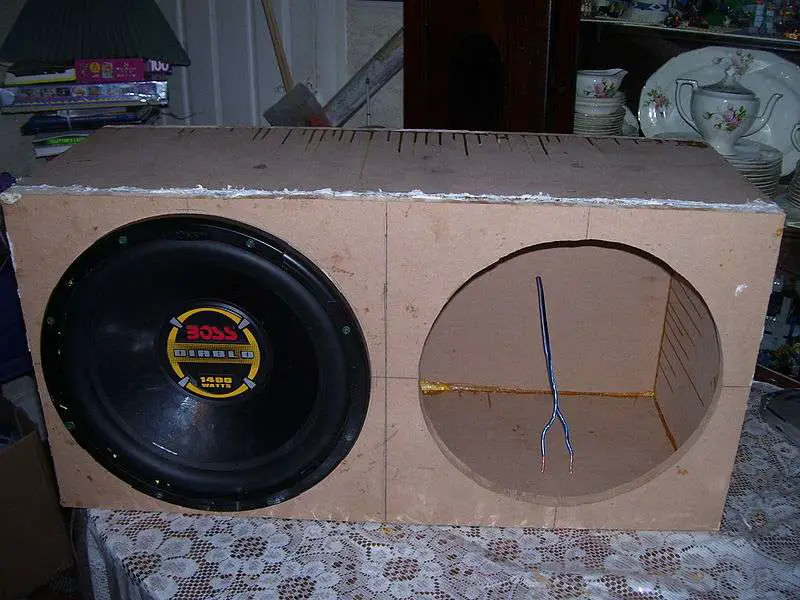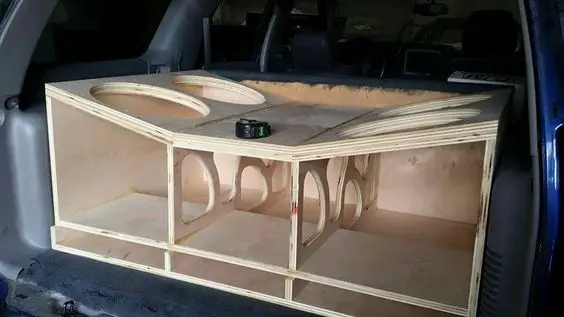A subwoofer box, also known as an enclosure or a speaker box, is an essential component of a car audio system.
It is designed to enhance the bass output of a subwoofer, allowing for deep and powerful low-frequency sound.

In this article, we will provide a detailed and comprehensive guide on how to build a subwoofer box for deep bass in a car.
Materials and Tools Needed
Before you begin building your subwoofer box, you will need to gather a few materials and tools. The materials you will need include:
MDF (medium-density fiberboard) board: This is the most commonly used material for building subwoofer boxes. It is strong, durable, and relatively inexpensive.
Glue: Use a high-quality wood glue to hold the pieces of the subwoofer box together.
Screws: Use wood screws to secure the MDF board pieces together.
Sealant: Use a sealant to seal any gaps or seams in the subwoofer box to prevent air leaks.
Subwoofer: Make sure you have the subwoofer that you will be using with the box.
The tools you will need include:
Saw: A circular saw or a table saw can be used to cut the MDF board to size.
Drill: You will need a drill to make holes for the screws and subwoofer.

Measuring tape: Use a measuring tape to measure and mark the MDF board pieces accurately.
Sandpaper: Use sandpaper to smooth out any rough edges on the MDF board pieces.
Designing the Subwoofer Box
Before you begin building the subwoofer box, you will need to design it. There are several factors to consider when designing the subwoofer box, including the size of the subwoofer, the space in the car, and the desired bass output.
Size of the Subwoofer:
The size of the subwoofer will determine the size of the subwoofer box. The subwoofer should fit snugly inside the box with a little extra room for movement.
Space in the Car:
The space in the car will determine where the subwoofer box can be placed. It is important to consider the available space before designing the subwoofer box.
Desired Bass Output:
The desired bass output will determine the size and shape of the subwoofer box. A larger box will provide more bass, while a smaller box will provide less bass.
Tips for creating a design that will provide deep bass:
A sealed box or a sealed enclosure, also known as acoustic suspension, is a good design choice as it allows tight and accurate bass response.
A ported box or a bass reflex enclosure is another good choice as it allows for more output, but it might not be as accurate as the sealed enclosure.
Also, make sure to properly calculate the enclosure volume and port area/length for the specific subwoofer you have.
Now that you have a clear understanding of the materials, tools, and design needed, the next step is to begin building the subwoofer box.
Building the Subwoofer Box
Once you have designed the subwoofer box, it’s time to begin building it. Follow these step-by-step instructions to build your subwoofer box:
Measure and mark the MDF board pieces:
Use the measuring tape to measure and mark the MDF board pieces according to the design of the subwoofer box.
Cut the MDF board pieces:
Use the saw to cut the MDF board pieces to the correct size and shape. Be sure to wear safety glasses and use caution when using power tools.
Assemble the subwoofer box:
Apply glue to the edges of the MDF board pieces and use the screws to secure them together. Make sure to clamp the pieces together while the glue dries.
Seal the gaps and seams:
Use the sealant to seal any gaps or seams in the subwoofer box to prevent air leaks. Be sure to let the sealant dry completely before moving on to the next step.
Install the subwoofer:
Measure and mark the location for the subwoofer and use the drill to make a hole for it. Install the subwoofer in the box and secure it with screws.
Sand the edges:
Use the sandpaper to smooth out any rough edges on the subwoofer box.

Tips for ensuring a tight seal between the subwoofer and the box to maximize bass:
- Make sure that the subwoofer is flush with the front of the box and that there are no gaps between the subwoofer and the box.
- Use a generous amount of sealant to seal the edges of the subwoofer and the hole in the box.
Installing the Subwoofer Box
Once the subwoofer box is built, it’s time to install it in the car. Follow these instructions to install the subwoofer box in your car properly:
Choose the location:
Decide where you want to install the subwoofer box in the car.
Make sure that the location you choose has enough space for the subwoofer box and that it will not interfere with any other components in the car.
Secure the subwoofer box:
Use screws or other hardware to secure the subwoofer box in place.
Make sure that the box is level and that it is not touching any other components in the car.
Wire the subwoofer:
Use the wiring diagram that came with the subwoofer to connect the subwoofer to the car’s audio system.
Make sure that all the connections are tight and that the wiring is properly grounded.
Fine-tune the settings:
Use the settings on the subwoofer and the car’s audio system to fine-tune the sound to your liking.
Conclusion
In this article, we provided a detailed and comprehensive guide on how to build a subwoofer box for deep bass in a car.
We covered the materials, tools, and design needed, as well as the step-by-step instructions for building and installing the subwoofer box.
A properly designed and built subwoofer box is essential for achieving deep and powerful bass in a car audio system.
We encourage readers to share their own experiences and tips for building a subwoofer box. Happy building!
What is the difference between a sealed box and a ported box?
A sealed box, also known as an acoustic suspension, is a subwoofer enclosure that doesn’t have any ports or vents.
This design allows for tight and accurate bass response. A ported box, also known as a bass reflex enclosure, is a subwoofer enclosure that has a port or vent.
This design allows for more output, but it might not be as accurate as the sealed enclosure.
Can I use other materials besides MDF to build a subwoofer box?
MDF is the most commonly used material for building subwoofer boxes because it is strong, durable, and relatively inexpensive.
However, you can also use other materials such as plywood, particleboard, or acrylic.
Keep in mind that the choice of material will affect the sound quality and durability of the subwoofer box.
Can I paint my subwoofer box?
Yes, you can paint your subwoofer box to match the interior of your car.
Make sure to use a paint that is suitable for use on wood and that you let the glue, sealant, and paint dry completely before installing the subwoofer.
Can I place my subwoofer box in the trunk of my car?
Yes, you can place your subwoofer box in the trunk of your car.
However, keep in mind that the trunk may not be the best location for the subwoofer box.
The best location for the subwoofer box is typically in the back seat area or in a custom-built enclosure in the trunk.
Can I use a single subwoofer or multiple subwoofers in the box?
You can use a single subwoofer or multiple subwoofers in the box, depending on your preference and the space available in your car.
Keep in mind that using multiple subwoofers will increase the overall output and bass response, but it will also require more space and additional wiring.
